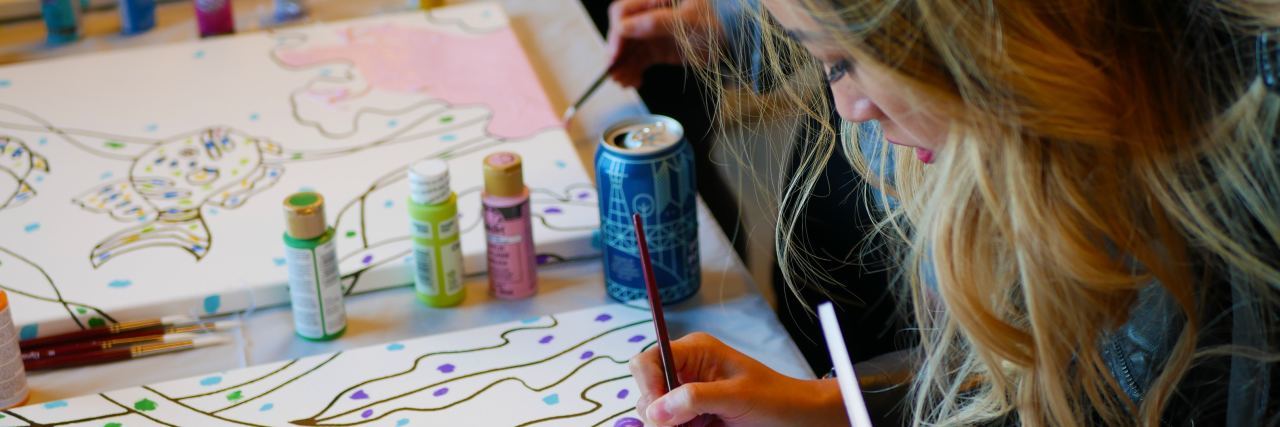What is Art Therapy?
Art therapy utilizes art as another mode of intervention, treatment and communication. It can be used in a variety of ways and with a variety of purposes. Art therapy is very personalized — you match the personality of the client to the type of art therapy. It can vary in terms of the type of medium and even the subject of what they are being asked to create visually by their therapist.
As a licensed art therapist, I have the opportunity to provide an open art studio where clients get to experiment with being around art materials. This open studio can range from 10 to 22 people. There’s a ton of art materials available, whether it’s clay, painting, drawing materials, “Shrinky Dinks,” string and so on. Clients can engage with these materials in any way they want.
You’ll find some clients socializing and sharing techniques with others, while there may be some who put in their headphones to zone out. It’s a great environment because they can come in and simply engage in mindfulness practice. They get to take part in whatever way they want to. There’s no expectation to create something amazing because it’s about being content with art-making in and of itself.
What are some examples of Art Therapy?
An example of catered art therapy would be asking the client to draw a wave of emotions passing over them. What does it look like? What resources do you have? Are you on a surfboard? Are you on a boat? Are you in a tank? Are you sitting on the shoreline looking at it?
Another exercise in art therapy would be for the client to draw their family system. What do the connections between them and their family look like? They may have symbols for the families, symbols for themselves. What do the links connecting each family member look like and what does it say about the family’s dynamic?
These particular exercises help bring additional insight into what the client is feeling they don’t how to express verbally. They might not have the language to express themselves, or it could be unexplainable to them. Being able to explore those feelings and emotions in art can be very powerful. Often clients are very creative and can surprise themselves.
The process of art therapy is flexible. It depends on what the client needs — whether it’s looking at their social support, talking about emotions they are feeling, or it could simply be using art therapy as a grounding mindfulness technique.
What are common challenges people see when trying art therapy?
When clients first start exploring with art therapy, it is very common, especially for adolescents, to struggle with their self-esteem. They don’t feel like they can do art because they think it needs to be a masterpiece. It’s hard for them to engage in art in a way that nothing is required. The idea to create for the sake of creating is hard to do for them. But art therapy is about exploration and hopefully enjoying the process too.
What are five benefits of art therapy?
The simple act of creating art and using mixed materials helps you to practice being mindful. It also engages your senses which can be very powerful.
2. It is a different form of communication.
Sometimes talking is not enough. A client might not know how to express what they are feeling. They might not have the language or even be aware of what they are feeling. Expressing emotions through art can provide some powerful insights into what a client is going through. It’s another form of expression and communication.
3. It can act as a self-soothing skill.
Creating art can be therapeutic for clients. It can be a way to distract oneself from what may be going on. It can help to self-soothe, a common dialectical behavior therapy (DBT) skill, and be a healthy form of coping.
4. It can provide additional insight.
Art therapy has the ability to explore and delve deeper into therapeutic issues. The artwork a client creates can act as another lens into their mind. This can provide some powerful insight to improve the quality of the client and therapist relationship. Some clients end up being surprised by the artwork they create and what insights they find.
5. It builds confidence.
Some clients will pull out the artwork they’ve created throughout their course of therapy. They can then see, through their art, how their mental health has improved. For example, a client might notice they started using more colors. Or their pictures became more expressive. Or the topics were more positive. It can serve as visual milestones of progress. This establishes confidence that they have had positive growth in their treatment.
How to get involved with art therapy.
Participating in art is always welcome and can be a great hobby to take part in. But for a full-guided experience, you would need to see a registered art therapist or an art therapist intern. There’s more to art therapy than the art itself — it’s about the questions a therapist asks and the exploration of the deep work the client is doing with a licensed therapist.
Art therapy is a powerful form of communication and expression that can provide additional insights into therapy treatment. If you feel art therapy can be beneficial for you or your family, then contact an art therapist today to see how they can help you.
For more, see the author’s website.
Photo by Rahul Jain on Unsplash

